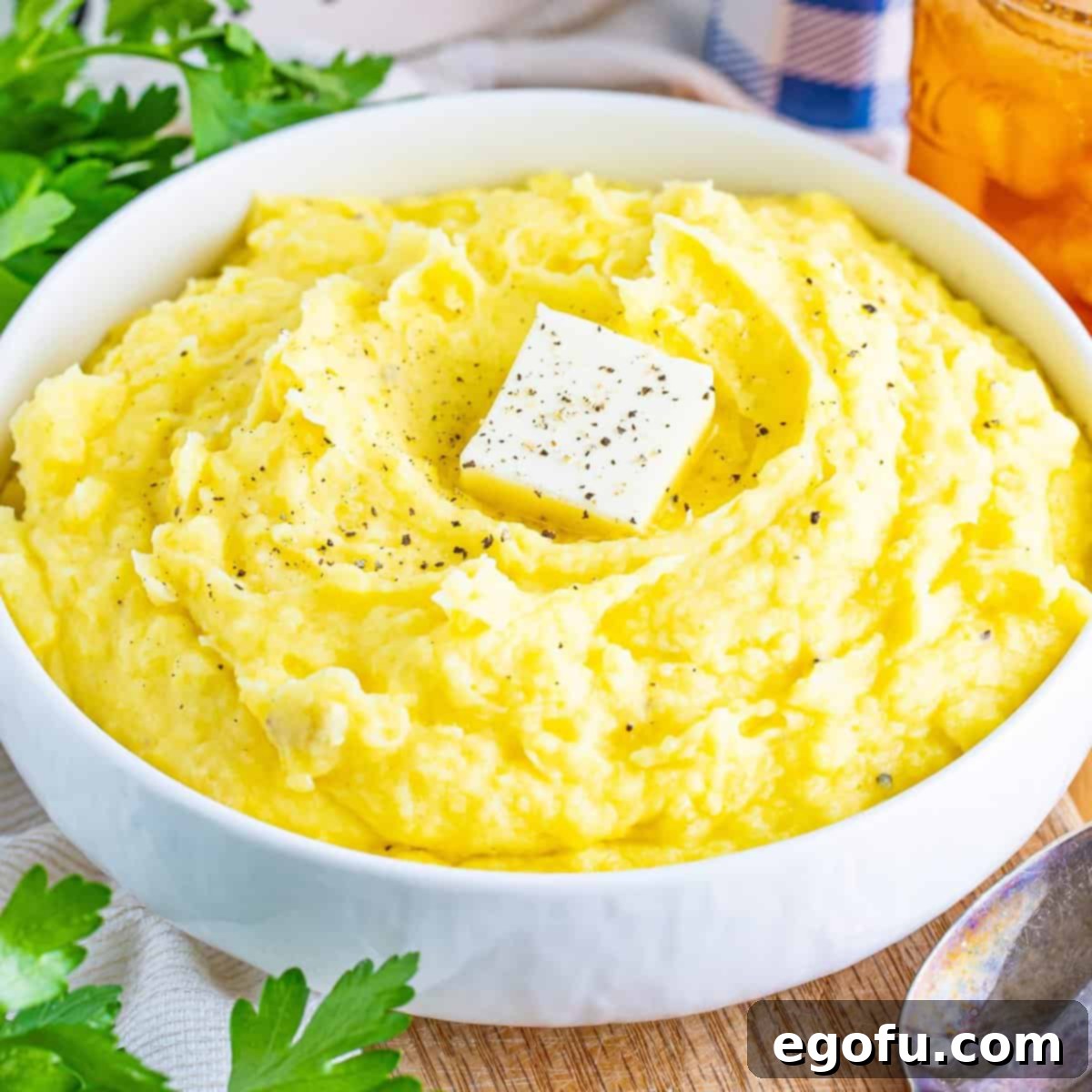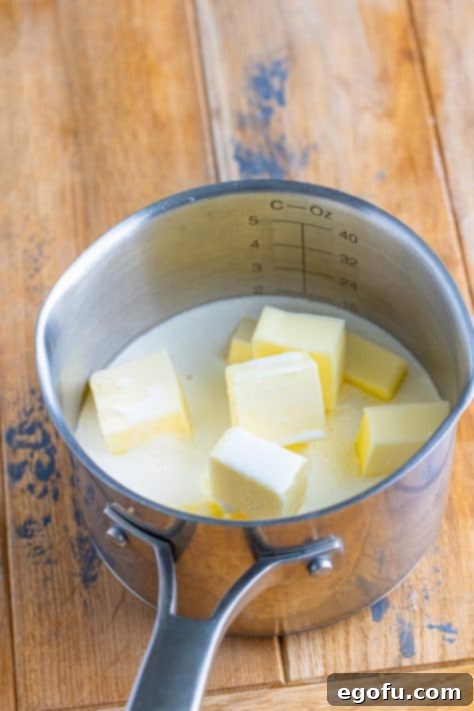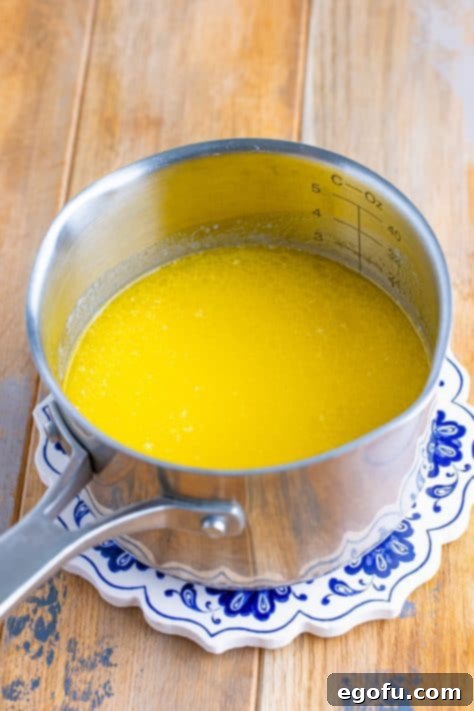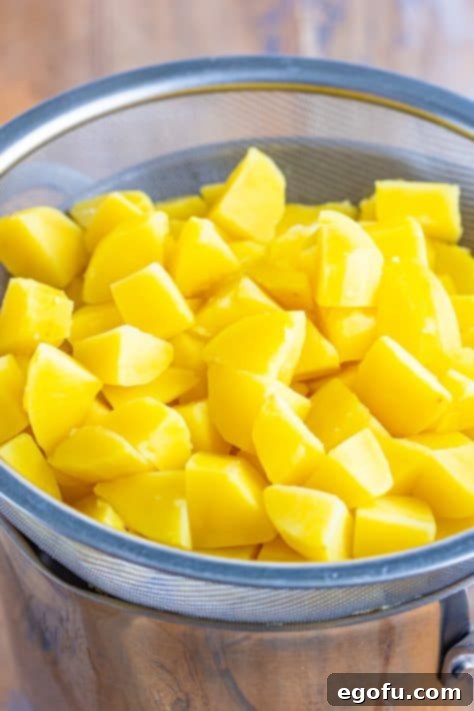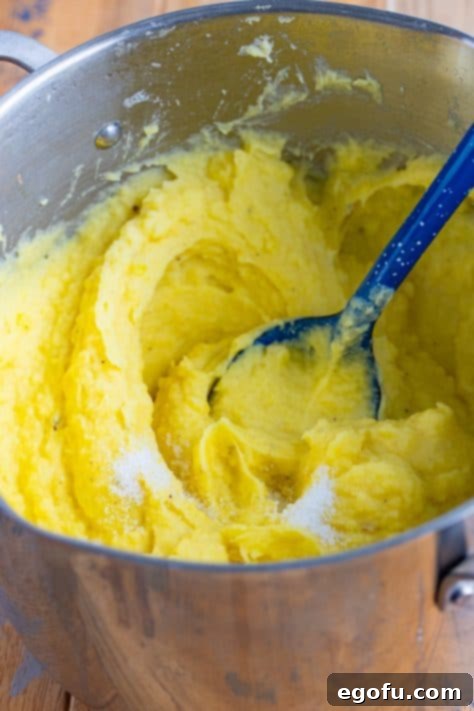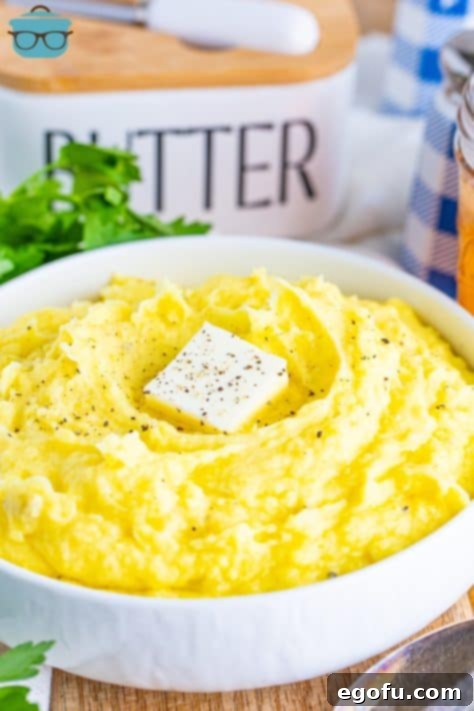Simple, incredibly creamy, and wonderfully fluffy, this perfected recipe for homemade Stovetop Mashed Potatoes requires only a few core ingredients and can be on your dinner table in approximately 30 minutes, making it ideal for any busy weeknight or festive gathering.
Effortless Stovetop Mashed Potatoes: A Speedy & Delicious Side Dish Recipe
Mashed potatoes are a timeless comfort food, cherished for their smooth texture and rich, buttery flavor. While there are many ways to prepare this beloved side dish, our stovetop method stands out for its unmatched speed and simplicity, delivering consistently perfect results every single time. Forget the long prep times or the need for specialized equipment; this recipe allows you to whip up a batch of delectable mashed potatoes with minimal fuss, making it your ultimate go-to for impromptu meals or when time is of the essence.
What truly elevates these creamy spuds, however, are a few carefully selected ingredients and techniques designed to enhance their natural goodness. We’ll delve into the secrets behind achieving that coveted light, airy, and buttery texture, ensuring your mashed potatoes are not just a side, but a highlight of your meal. Whether you’re a seasoned cook or a kitchen novice, this guide promises to elevate your mashed potato game. Get ready for a fast track to fluffy perfection!

Frequently Asked Questions About Stovetop Mashed Potatoes
While Yukon Gold potatoes are our top recommendation for this recipe due to their naturally creamy texture, thin skin (which can sometimes be left on for extra fiber and rustic appeal), and buttery flavor, you absolutely have options. Yukon Golds possess a medium starch content that mashes beautifully without becoming gluey, yielding a velvety consistency. Russet potatoes, known for their higher starch content, also produce very fluffy mashed potatoes, though they might require a bit more liquid to achieve the same creamy richness. For a slightly different twist, you can use red potatoes, and we often prefer to leave their skins on for added color, nutrients, and a rustic charm. No matter your choice, ensure they are peeled and cut into uniform 1-inch cubes for even cooking, which is crucial for uniform tenderness.
Yes, absolutely! If you adore the decadent richness and subtle tang that cream cheese brings to our popular Million Dollar Mashed Potatoes, you can certainly introduce it here. Cream cheese adds an incredible depth of flavor and an even silkier texture, transforming these already delicious spuds into an extra-special dish perfect for holidays or an elevated weeknight meal. For this stovetop recipe, we recommend starting with half a block (about 4 ounces) of softened cream cheese. Incorporate it after mashing the potatoes with the butter and cream mixture, then taste and add more if you desire a more pronounced cream cheese flavor or an even richer, more luxurious consistency. Always ensure the cream cheese is at room temperature for seamless blending and to avoid lumps.
Heating your dairy and stock mixture is a critical step for achieving perfectly fluffy and smooth mashed potatoes, helping to prevent a gummy or sticky texture. When cold ingredients are added directly to hot, mashed potatoes, the sudden temperature difference causes the starches within the potatoes to seize up and contract. This forces you to stir more vigorously and for longer periods to fully incorporate the cold liquids, which in turn leads to overworking the potatoes. Overworked potatoes release too much starch, resulting in that undesirable gluey, unappetizing consistency. By warming the butter, heavy cream, and chicken stock to a gentle heat, they are much more readily absorbed by the tender potatoes, requiring minimal stirring and thus preserving their light, airy, and fluffy texture. This simple trick truly makes all the difference in achieving mashed potato perfection.
While some cooks use electric mixers for potatoes, we generally advise against it for achieving the ideal fluffy, light texture. Electric mixers, especially powerful stand mixers, can easily overwork the potatoes in a matter of seconds. The high-speed rotation breaks down too many potato cells, releasing excessive amounts of starch. This leads to a sticky, gummy, and unappetizing consistency, rather than the light and airy mashed potatoes we all crave. For the absolute best results, a good old-fashioned potato masher or a potato ricer is your best friend. A ricer will produce the smoothest, most lump-free potatoes with minimal effort and virtually no risk of overworking. If you prefer a slightly chunkier, more rustic mash, a sturdy hand masher works perfectly. Plus, sticking to hand tools often means fewer complex dishes to clean!
Infusing your mashed potatoes with garlic flavor is a fantastic idea and a popular variation! For a deep, mellow, and slightly sweet garlic flavor, we highly recommend adding a head of roasted garlic. Simply squeeze the softened, caramelized cloves from their skins and mash them in with your potatoes and liquids. The roasting process removes the harshness of raw garlic, leaving a wonderfully aromatic sweetness. Alternatively, you can mince 2-3 cloves of fresh garlic and sauté them gently in a tablespoon of butter until fragrant before adding them to your warm cream mixture. For a simpler, yet still effective, option, a teaspoon of garlic powder can be added along with your salt and pepper. Feel free to adjust the amount of garlic to suit your personal taste preference and desired intensity.
While this particular recipe is expertly optimized for the stovetop to deliver quick preparation and immediate results, mashed potatoes can certainly be made successfully in a slow cooker! The method differs slightly, as slow cooking allows the potatoes to gently cook and absorb flavors over a longer period, making it ideal for hands-off preparation or when you need to free up stovetop space. For a dedicated slow cooker recipe that ensures the same creamy and delicious results, we highly recommend checking out our popular Crock Pot Million Dollar Mashed Potatoes recipe. It’s perfect for make-ahead convenience, especially when entertaining a crowd or preparing for a holiday feast, allowing you to focus on other dishes.
Leftover stovetop mashed potatoes are a delicious bonus and can be easily stored! To store them, allow the mashed potatoes to cool completely, then transfer them to an airtight container. They will keep fresh in the refrigerator for up to 4 days. For longer storage, mashed potatoes freeze remarkably well. Place them in a freezer-safe bag or container, removing as much air as possible to prevent freezer burn, and they will maintain their quality for up to 3 months. To reheat, thaw frozen mashed potatoes in the refrigerator overnight. For both refrigerated and thawed potatoes, gently reheat them on the stovetop over low heat, adding a splash of milk, heavy cream, or chicken stock and a pat of butter to restore their creamy consistency and moisture. Stir frequently and gently to prevent sticking and maintain their fluffy texture, avoiding high heat which can alter their texture.
Watery mashed potatoes are often the result of not thoroughly draining the cooked potatoes. After boiling, ensure you drain the potatoes very well, even letting them sit in the empty hot pot for a minute or two over low heat to allow any excess moisture to steam off. This crucial “drying” step concentrates the potato flavor and prevents dilution. Gluey mashed potatoes, on the other hand, typically occur from over-mashing. As discussed, limit the use of electric mixers and mash only until your desired consistency is reached. Additionally, carefully measure your liquids (butter, cream, stock) and add them gradually as you mash. It’s always easier to add more liquid than to try and salvage overly wet potatoes. Starting with a smaller amount and adjusting to your desired consistency will help you avoid both watery and gluey results, ensuring a perfect fluffy and creamy texture.
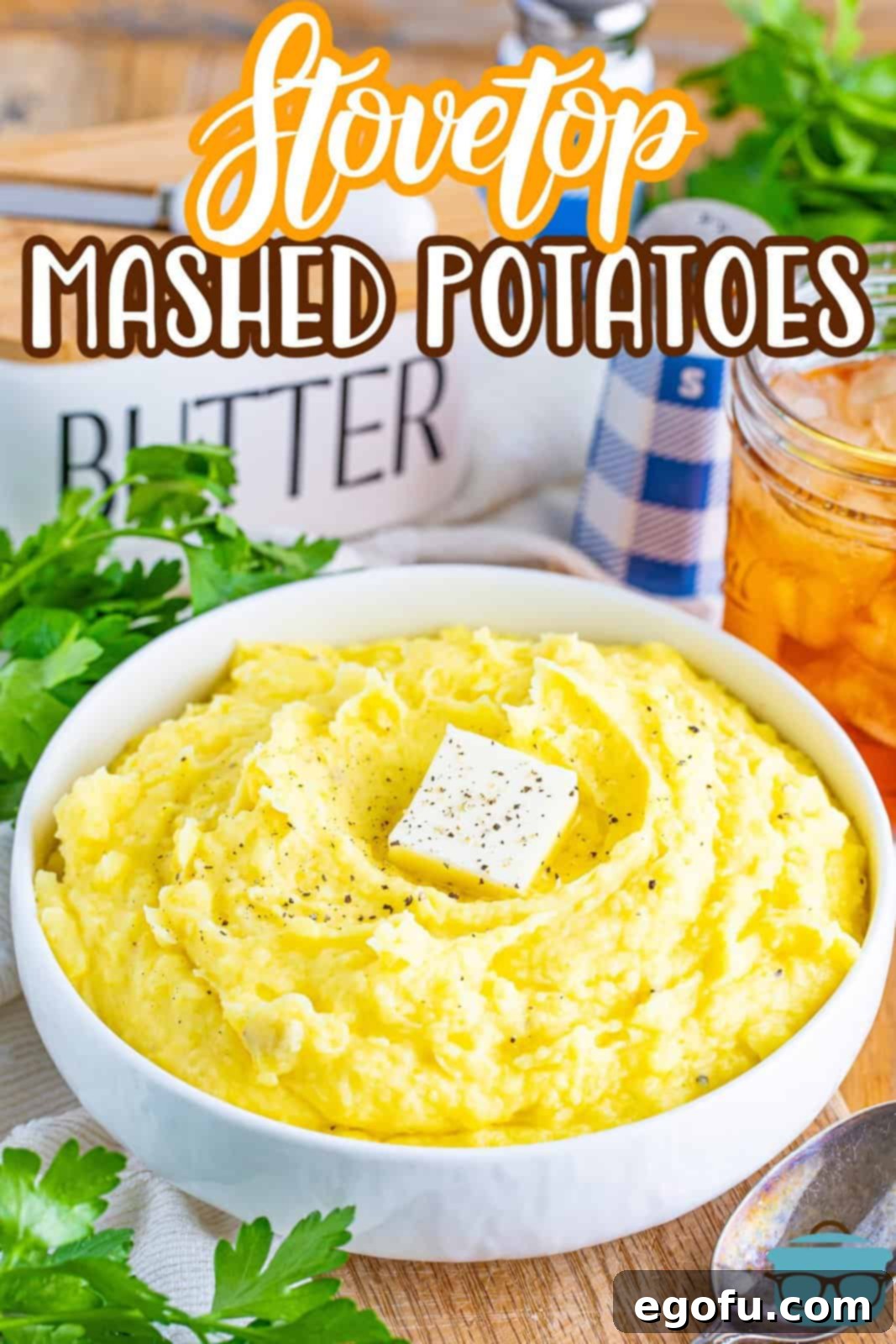
Key Ingredients for Unforgettable Stovetop Mashed Potatoes
Crafting the perfect mashed potatoes starts with understanding the role each ingredient plays in achieving that ideal creamy, fluffy texture and rich flavor. Here’s a closer look at what you’ll need and why:
- Yukon Gold Potatoes: These are the undisputed star of our show. Their distinctive golden flesh and inherently creamy texture make them superior for mashing, yielding a velvety smooth result without excessive effort. They boast just the right amount of starch to break down easily when cooked but not so much that they become gluey, striking the perfect balance. If Yukon Golds aren’t readily available, russet potatoes can be used for a fluffier, slightly drier mash, or red potatoes with their skins on for a vibrant, rustic touch, though you might need to slightly adjust the liquid amounts.
- Salted Butter: Butter is more than just a fat in this recipe; it’s a foundational flavor enhancer and contributes significantly to the luxurious richness and melt-in-your-mouth feel of mashed potatoes. We recommend using good quality salted butter for a robust base flavor. If you opt for unsalted butter, remember to adjust the amount of salt added later, likely needing a bit more to achieve the desired seasoning. While margarine can be used in a pinch, be mindful of its salt content and how it may subtly alter the overall taste and creaminess compared to real butter.
- Chicken Stock (or Broth): This is truly our secret ingredient, the “special sauce” that distinguishes these mashed potatoes from typical recipes. Chicken stock introduces an incredible depth of savory, umami flavor that water simply cannot replicate. It adds a subtle complexity that makes these potatoes irresistibly delicious and far from bland. Opt for a low-sodium or no-sodium chicken broth if you prefer precise control over the saltiness, adding it gradually as you taste. For a vegetarian version, a good quality vegetable broth is an excellent alternative that still provides that essential flavor boost.
- Heavy Cream: For unparalleled creaminess and richness, heavy cream is absolutely non-negotiable in this recipe. Its high-fat content ensures a luscious, decadent texture that makes every bite heavenly. While you technically can substitute with whole milk, you will undoubtedly miss out on the superior, melt-in-your-mouth experience that heavy cream delivers, resulting in a less luxurious outcome. For the best possible mashed potatoes—the kind that truly impress—stick with heavy cream. Its velvety contribution is worth it.
- Black Pepper and Salt: These essential seasonings are vital for balancing and enhancing all the flavors within your mashed potatoes. Freshly ground black pepper adds a fragrant, earthy kick, while salt is crucial for bringing all the ingredients together and making them truly shine. Seasoning is highly subjective, so our strongest recommendation is to start with a modest amount, then taste and adjust as you go. Remember, you can always add more salt, but you can’t easily take it away! Consider a pinch of white pepper for a more subtle heat without visible dark flecks, especially if presentation is key.

How to Make the Best Stovetop Mashed Potatoes: Step-by-Step Guide
Follow these detailed steps to create perfectly creamy, fluffy, and flavorful mashed potatoes on your stovetop:
Prepare the Potatoes: Peel 3 pounds of Yukon gold potatoes and cut them into uniform 1-inch cubes. Uniform sizing is essential for even cooking. Place the cubed potatoes into a large, heavy-bottomed stockpot. Cover them completely with cold water, ensuring the water level is about 2 inches above the potatoes. Starting with cold water is a critical step as it allows the potatoes to cook more evenly from the outside in, preventing the exteriors from becoming mushy while the centers remain firm.

Boil the Potatoes: Place a lid on the stockpot and bring the water to a rolling boil over high heat. Once the water is vigorously boiling, reduce the heat slightly to maintain a steady, gentle simmer. Boil the potatoes until they are very tender – they should be easily pierced with a fork without any resistance or firmness – which typically takes about 15-20 minutes, depending on the size of your potato cubes. Stir occasionally to prevent the potatoes from sticking to the bottom of the pot and to ensure even cooking throughout.
Prepare the Warm Liquid Mixture: While the potatoes are actively boiling, begin preparing your flavorful liquid. Combine 1 cup of salted butter (cut into smaller pieces for faster melting), ½ cup of rich chicken stock, and ½ cup of heavy cream in a small saucepot. Place this saucepot over medium-low heat. The goal here is to warm the mixture gently, allowing the butter to melt completely and all ingredients to become warm to the touch. This crucial step prevents the starches in the potatoes from seizing when the liquids are added.

Heat the Liquid Gently: Continue to warm the butter, stock, and cream mixture. It’s important not to bring it to a full boil or even a strong simmer; you simply want it hot enough to be fully melted and well-integrated. Stir occasionally to ensure the butter melts evenly and the mixture is uniformly warm. This warm liquid will be readily and smoothly absorbed by the potatoes, ensuring a silky-smooth texture without requiring excessive mashing, thus preventing gumminess.

Drain and Dry Potatoes Thoroughly: Once the potatoes are perfectly fork-tender, carefully drain them very well in a colander, ensuring all the cooking water is removed. To guarantee they are as dry as possible, return the drained potatoes to the empty hot stockpot over very low heat for 1-2 minutes, gently shaking the pot. This crucial step helps any residual moisture to steam off, which is absolutely key to preventing watery mashed potatoes and allowing them to better absorb the rich, creamy liquid mixture, concentrating their flavor.

Mash to Perfection: Return the dried potatoes to the hot pot. Add about one-third of the warm cream mixture. Begin mashing with a sturdy potato masher, working gently but thoroughly. Continue adding more of the liquid gradually, mashing until you achieve your desired consistency. Some prefer a slightly lumpy, rustic mash, while others aim for an ultra-smooth, restaurant-quality puree. We typically use all the liquid for a maximally rich and creamy mash, but you can adjust to your personal preference. Remember, mash just until smooth; over-mashing can lead to that undesirable gluey texture.

Season and Taste: Stir in ½ teaspoon of freshly ground black pepper. Now, it’s time for the most important part of seasoning: taste the mashed potatoes and add salt to your preference. The precise amount of salt needed will vary significantly depending on whether you used salted or unsalted butter and the sodium content of your chosen chicken stock. Start with about 1 teaspoon of salt if you’re unsure, then add small pinches and taste after each addition until the flavor is perfectly balanced and vibrant. This step is absolutely critical for a truly delicious and well-rounded outcome.

Serve Immediately: For the absolute best flavor, texture, and warmth, serve your creamy, fluffy stovetop mashed potatoes immediately after preparing them. They are at their peak when piping hot. Garnish with an extra pat of butter, finely chopped fresh chives, fresh parsley, or a sprinkle of paprika if desired for an extra touch of elegance and fresh flavor. Enjoy!

Tips for the Fluffiest, Creamiest Mashed Potatoes
Achieving truly exceptional mashed potatoes is all about technique. Here are our top tips to ensure your stovetop mashed potatoes are always light, airy, and wonderfully creamy:
- Start with Cold Water: Always begin boiling your peeled and cubed potatoes in cold water. This allows the potatoes to heat up gradually and cook evenly from the outside to the inside, preventing the outsides from overcooking and becoming mushy while the centers remain firm.
- Proper Draining is Key: After cooking, drain your potatoes thoroughly. Returning them to the hot, empty pot for a minute or two over very low heat, gently shaking, helps evaporate any lingering excess moisture. This crucial step prevents watery mashed potatoes and ensures they can properly absorb the rich, creamy liquids.
- Warm Your Dairy and Stock: Heating the butter, cream, and stock mixture before adding it to the potatoes is a non-negotiable step. This prevents the starches from seizing due to a sudden temperature drop, which can result in a gummy or grainy texture. Warm liquids are readily absorbed, leading to a smoother, lump-free mash.
- Don’t Overmash: This is perhaps the most important tip. Mash only until the desired consistency is reached – whether you prefer a rustic, slightly lumpy texture or a perfectly smooth puree. Overmashing develops the starches excessively, leading to a gluey or sticky texture that is hard to remedy. A potato ricer or a sturdy hand masher is ideal for this task, avoiding electric mixers.
- Taste and Adjust Seasoning: Salt and pepper are paramount to a flavorful dish. Always taste your mashed potatoes before serving and adjust the seasoning as needed. The type of butter (salted or unsalted) and the sodium content of your chicken stock will significantly influence the final saltiness, so adjust to your preference.
Delicious Variations & Serving Suggestions
While classic stovetop mashed potatoes are a delightful side dish on their own, their versatility makes them a fantastic base for endless creative variations and a perfect accompaniment to a wide array of main courses:
Creative Mashed Potato Variations:
- Garlic & Herb Infusion: Beyond roasted garlic, experiment with mixing in finely chopped fresh herbs like chives, fresh parsley, rosemary, or thyme for a vibrant, aromatic boost. A touch of garlic powder or onion powder can also be added for convenience.
- Cheesy Indulgence: Fold in shredded cheddar, smoked Gouda, Parmesan, Gruyère, or Monterey Jack cheese for an extra layer of savory flavor and gooey richness. Cream cheese (as mentioned in the FAQ) also adds a wonderful tang.
- Bacon & Scallion Delight: Stir in crispy crumbled bacon bits and thinly sliced fresh green onions (scallions) for a savory, smoky, and visually appealing addition.
- Sour Cream & Chive Tang: A generous dollop of sour cream or thick Greek yogurt adds a pleasant, refreshing tang and an extra dimension of creaminess, especially when paired with fresh chives.
- Brown Butter Sage: Elevate your potatoes by browning your butter gently until it turns amber and nutty before adding it to the cream mixture. Infuse it with fresh sage leaves for a sophisticated, earthy flavor profile.
- Spicy Kick: For those who enjoy a little heat, a pinch of cayenne pepper, a dash of your favorite hot sauce, or a finely minced jalapeño (seeds removed) can add a subtle, exciting warmth.
Perfect Pairings for Mashed Potatoes:
- Classic Roast Dinners: Mashed potatoes are the quintessential accompaniment to roast chicken, tender pot roast, holiday turkey, or savory pork loin.
- Steak & Chops: A creamy bed of mashed potatoes perfectly balances a juicy grilled steak, succulent lamb chops, or pan-seared pork chops, soaking up all the delicious juices.
- Gravy Lover’s Dream: They are simply incomplete without a generous pour of homemade gravy. Our KFC-style gravy is a fan favorite and an ideal match.
- Hearty Stews: Serve alongside rich beef stew, flavorful chicken and dumplings, or a rustic shepherd’s pie for a truly comforting and complete meal.
- Meatloaf: The ultimate nostalgic comfort food duo, where the mashed potatoes provide a creamy counterpoint to the savory meatloaf.
Craving More Potato & Comfort Food Recipes?
- KFC Gravy
- Southern Fried Chicken
- Crock Pot Million Dollar Mashed Potatoes
- Mashed Potato Soup
- Potato Rolls
- Crunchy Roasted Potatoes
- Potato Cakes
- Instant Pot Garlic Mashed Potatoes
- Creamy Garlic Potato Packets
- Melting Potatoes
- Crock Pot Garlic Parmesan Potatoes
- Crock Pot Creamy Fingerling Potatoes
- Crock Pot Baked Potatoes
- Honey Glazed Sweet Potatoes

Stovetop Mashed Potatoes
Creamy and unbelievably delicious, master the best mashed potatoes on your stove with this simple, quick, and foolproof recipe for an ultimate comfort food side dish.
Cook Time: 20 minutes
Total Time: 35 minutes
Author: Brandie Skibinski
Pin Recipe
Ingredients
- 3 pounds Yukon gold potatoes, peeled and cut into 1-inch cubes
- 1 cup salted butter
- ½ cup chicken stock (recommended brand)
- ½ cup heavy cream (recommended brand)
- ½ teaspoon black pepper (recommended brand)
- Salt, to taste
Instructions
- Place 3 pounds of peeled and 1-inch cubed Yukon gold potatoes into a large stockpot. Cover them with cold water, about 2 inches over the potatoes.
- Place a lid on the pot and bring the potatoes to a boil. Boil until very tender, approximately 15-20 minutes, stirring occasionally.
- While potatoes boil, add 1 cup salted butter, ½ cup chicken stock, and ½ cup heavy cream to a small saucepot. Place over medium-low heat.
- Allow the butter to melt and the mixture to warm through. Do not simmer; just keep it warm, stirring occasionally.
- Once potatoes are fork-tender, drain them thoroughly and return them to the empty pot.
- Add about ⅓ of the warm cream mixture and begin mashing with a potato masher. Gradually add more liquid until your desired mashed potato texture is achieved. (We typically use all of it for maximum creaminess.)
- Stir in ½ teaspoon black pepper. Taste and add more salt as desired. (We typically add 1 teaspoon of salt, but this varies based on your butter and stock.)
- Serve your delicious stovetop mashed potatoes immediately.
Notes
- Please refer to our detailed FAQ’s and ingredient list above for other substitutions or for answers to common questions.
- For an even smoother consistency, a potato ricer can be used instead of a hand masher.
- Consider garnishing with fresh chives, parsley, or a sprinkle of paprika for added flavor and visual appeal.
Cuisine: American
Nutrition
Calories: 521kcal | Carbohydrates: 41g | Protein: 6g | Fat: 38g | Sodium: 291mg | Fiber: 5g | Sugar: 3g
Nutritional Disclaimer
“The Country Cook” is not a dietician or nutritionist, and any nutritional information shared is an estimate. If calorie count and other nutritional values are important to you, we recommend running the ingredients through whichever online nutritional calculator you prefer. Calories and other nutritional values can vary quite a bit depending on which brands were used.
Did you make this recipe? Share it on Instagram @thecountrycook and mention us #thecountrycook!
